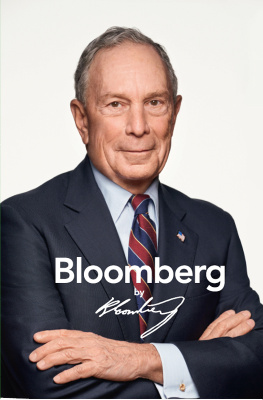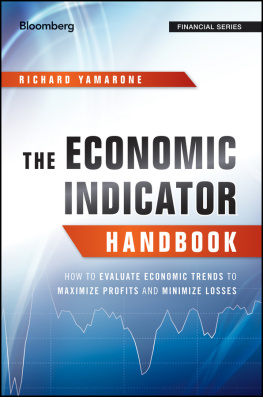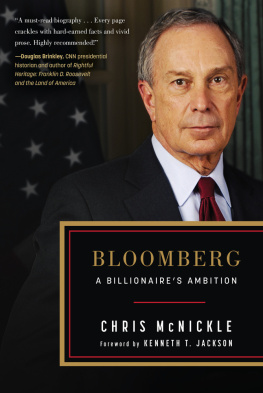
Cover image: Gregory Heisler
Cover design: Bloomberg
Copyright 2019 by Michael Bloomberg. All rights reserved.
Published by John Wiley & Sons, Inc., Hoboken, New Jersey.
Published simultaneously in Canada.
No part of this publication may be reproduced, stored in a retrieval system, or transmitted in any form or by any means, electronic, mechanical, photocopying, recording, scanning, or otherwise, except as permitted under Section 107 or 108 of the 1976 United States Copyright Act, without either the prior written permission of the Publisher, or authorization through payment of the appropriate per-copy fee to the Copyright Clearance Center, Inc., 222 Rosewood Drive, Danvers, MA 01923, (978) 750-8400, fax (978) 646-8600, or on the Web at www.copyright.com. Requests to the Publisher for permission should be addressed to the Permissions Department, John Wiley & Sons, Inc., 111 River Street, Hoboken, NJ 07030, (201) 748-6011, fax (201) 748-6008, or online at www.wiley.com/go/permissions.
Limit of Liability/Disclaimer of Warranty: While the publisher and author have used their best efforts in preparing this book, they make no representations or warranties with respect to the accuracy or completeness of the contents of this book and specifically disclaim any implied warranties of merchantability or fitness for a particular purpose. No warranty may be created or extended by sales representatives or written sales materials. The advice and strategies contained herein may not be suitable for your situation. You should consult with a professional where appropriate. Neither the publisher nor author shall be liable for any loss of profit or any other commercial damages, including but not limited to special, incidental, consequential, or other damages.
For general information on our other products and services or for technical support, please contact our Customer Care Department within the United States at (800) 762-2974, outside the United States at (317) 572-3993, or fax (317) 572-4002.
Wiley publishes in a variety of print and electronic formats and by print-on-demand. Some material included with standard print versions of this book may not be included in e-books or in print-on-demand. If this book refers to media such as a CD or DVD that is not included in the version you purchased, you may download this material at http://booksupport.wiley.com. For more information about Wiley products, visit www.wiley.com.
Library of Congress Cataloging-in-Publication Data
Names: Bloomberg, Michael, author. | Winkler, Matthew, author.
Title: Bloomberg by Bloomberg / Michael R. Bloomberg.
Description: revised edition. | Hoboken, New Jersey : Wiley, 2019. |
Identifiers: LCCN 2018046908 (print) | LCCN 2018047878 (ebook) | ISBN
978-1-119-55456-1 (Adobe PDF) | ISBN 978-1-119-55458-5 (ePub) | ISBN 978-1-119-55426-4
(hardback)
Subjects: LCSH: Bloomberg, Michael. | Capitalists and financiersUnited
StatesBiography. | InvestmentsUnited States. | BusinessmenUnited
StatesBiography. | TelecommunicationUnited States. | MayorsNew York
(State) New YorkBiography. | New York (N.Y.) Politics and
government1951 | BISAC: BIOGRAPHY & AUTOBIOGRAPHY / Business.
Classification: LCC HG172.B56 (ebook) | LCC HG172.B56 A3 2019 (print) | DDC
384.092 [B] dc23
LC record available at https://lccn.loc.gov/2018046908
To
Everyone at Bloomberg
who helped make the company what it is today,
and for making Bloomberg Philanthropies possible.
Preface
Two decades after Bloomberg by Bloomberg first appeared on bookshelves, so much has changed at the company. We have grown from 3,500 employees in 50 countries to 19,000 employees in more than 120 countries, and from 87,500 Bloomberg Terminals to 325,000, with Asia as our fastest-growing market. Weve expanded to include a wide variety of products and services beyond the Terminal, including those that help companies manage their own operations and systems. News stories once published exclusively on the Terminal are now read by millions on the Web and social media platforms, with many syndicated internationally. And along the way, we became the first global news service to win every major journalism award in print and broadcast media, including the Pulitzer Prize.
What started in 1981 with four guys and a coffee potand not one customerhas grown beyond our wildest imaginations. And yet on the most important measures, Bloomberg has not changed at all. The culture that we created at the very beginning continues to define who we are: We are still a company that will outwork our competitors, take more risks than they will, serve our customers better, invest more in the long term, and place greater emphasis on transparency and teamwork. The design of our physical environment is still the sameno private offices. I have the same desk space as everyone else in the company. We have never stopped believing that our greatest asset is our own people, and we invest in them and reward them accordingly.
We remain deeply committed to using our success to benefit others. The vast majority of our profits go to support philanthropic causesonly now both our profits and ambitions are much larger than they once were, and the giving is managed by Bloomberg Philanthropies. Giving back has always been a big part of our companys identity, and as long as Im in charge, it always will be.
The technology that we pioneered in the early 1980s has long been ancient history. But we never made the error that so many others have: mistaking their product for the device that delivers it. Executives at Eastman Kodak, for instance, thought they were in the camera and film business, instead of the photography business. The digital photography revolution passed them by, and after more than a century as one of the most innovative companies in the world, they filed for bankruptcy in 2012. At Bloomberg, we got out of the business of building physical computers as soon as PCs began taking off. We knew our core product was data and analytics, not hardware.
Look ahead or fall behind. Were still looking ahead.
When we started the company in a small room on Madison Avenue, we were refugees from Wall Street motivated by an idea that we could build something new that just might make a difference in the world of finance. People told me I was crazy to think we could overturn the status quo on Wall Street and challenge the giants of financial information. Maybe I was. But within a few years, we had our first customer. And from an initial bond product, we branched out into stocks, commodities, and news. We added magazines, radio, and televisionall built upon the mountain of data and information generated by the Terminal and demanded by the worlds most influential business and financial professionals. Before the Internet existed, we had created the worlds most powerful intranet. And before the phrase social network came to be, we had created one for the financial services industry.
A few years after writing the first edition of this book, I stepped away from running the company to run for mayor of New York Cityanother idea that people thought was crazy. But it had been twenty years since we started the company, and I was ready for a new challenge. Besides, Ive always believed that the next person can do it better. If a company cant survive a change at the top, the top person hasnt done her or his job. Talent development is one of a CEOs most important responsibilities.
The talented team of people who led the company in my absencewith Peter Grauer, Tom Secunda, Dan Doctoroff, and Lex Fenwick playing key rolesdid an extraordinary job. They even managed to grow the business during the worst economic recession in decades. As most of our customers (those that survived anyway) slashed their payrolls, we found new markets by offering new services. Diversifying the business positioned us for a new era of growth. After twelve years in office, I returned to find the company stronger than ever, and resumed leading it.
Next page





